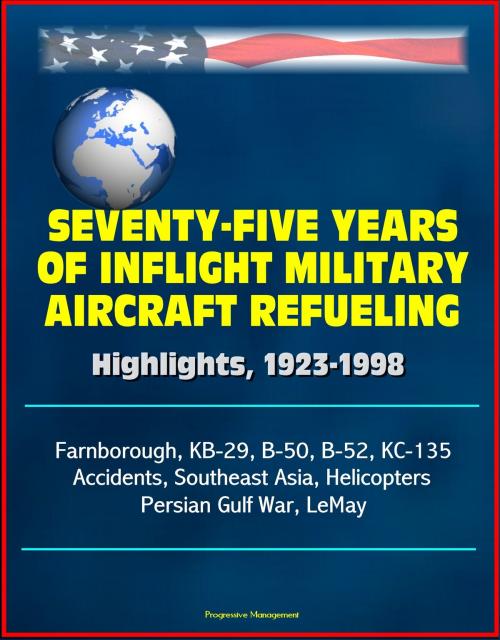Seventy-Five Years of Inflight Military Aircraft Refueling: Highlights, 1923-1998 - Farnborough, KB-29, B-50, B-52, KC-135, Accidents, Southeast Asia, Helicopters, Persian Gulf War, LeMay
Nonfiction, History, Middle East, Persian Gulf War, Military, Aviation| Author: | Progressive Management | ISBN: | 9781311071491 |
| Publisher: | Progressive Management | Publication: | August 7, 2015 |
| Imprint: | Smashwords Edition | Language: | English |
| Author: | Progressive Management |
| ISBN: | 9781311071491 |
| Publisher: | Progressive Management |
| Publication: | August 7, 2015 |
| Imprint: | Smashwords Edition |
| Language: | English |
Professionally converted for accurate flowing-text e-book format reproduction, this Air Force publication examines the history of military aircraft inflight refueling, beginning with the first, in 1923.
On June 27, 1923, at an altitude of about 500 feet above Rockwell Field on San Diego's North Island, two US. Army Air Service airplanes became linked by hose, and one airplane refueled the other. While only seventy-five gallons of gasoline were transferred, the event is memorable because it was a first. The summer of 1998 marks the seventy-fifth anniversary of the use of this elementary technique of range extension. The airplanes were de Havilland DH-4Bs, single-engine biplanes of 4,600 pounds. First Lt. Virgil Hine piloted the tanker; 1st Lt. Frank W. Seifert occupied the rear cockpit and handled the fueling hose. Capt. Lowell H. Smith flew the receiver while 1st Lt. John Paul Richter handled the refueling from the rear cockpit. The refueling system consisted of a fifty-foot length of rubber hose, trailed from the tanker, with a manually operated quick-closing valve at each end. The process is best described in terms of "you dangle it; I'll grab it." After six hours and thirty-eight minutes, and only one refueling, engine trouble in the receiver terminated the flight. Recognizing that a second refueling plane would provide more safety and flexibility, the next attempt included a third DH-4 as the second refueler. Its crew members were Capt. Robert G. Erwin and 1st Lt. Oliver R. McNeel, who became the world's second refuelers. On August 27 and 28, with fourteen midair contacts, tankers operated by Hine and Seifert and Erwin and McNeel kept Smith and Richter in the air over a prescribed track for thirty-seven hours and twenty-five minutes (see Appendix 1 for a schedule of refuelings and deliveries), and set a world record for endurance. The track flown was 3,293 miles, about the same distance as that from Goose Bay, Labrador, to what was Leningrad in the Soviet Union.
The First Refueling * The Question Mark and Its Answer * Aeronautical Flagpole Sitting * Refueling at Farnborough * The Modern Airplane Defers Refueling * A British Dilemma and the American Solution * Sir Alan Cobham and FRL, the British Solution * Wartime Might-Have-Beens * Refueling Frustrations and the Onset of the Cold War * The Aircraft and Weapons Board * The KB-29 and B-50 * Lucky Lady II: Air Refueling Accident * The Probe and Drogue * The Cold War Gets Hot, Refueling Becomes Vital * Boom Versus Probe and Drogue Refueling * The B-52 and KC-135 * Tankers Aweigh * Tactical Air Command Adopts Aerial Refueling * SAC, TAC, SIOP, and Tankers * In Europe: NATO and Others * The War in Southeast Asia * Refueling Helicopters * Moments of Truth * The Aerial Refueling Systems Advisory Group * Aeronautica Geriatrica * The Advanced Tanker Cargo Aircraft/KC-10 * EL Dorado Canyon; The Longest Fighter Mission * The Persian Gulf War * The Legacy of Curtis LeMay
Professionally converted for accurate flowing-text e-book format reproduction, this Air Force publication examines the history of military aircraft inflight refueling, beginning with the first, in 1923.
On June 27, 1923, at an altitude of about 500 feet above Rockwell Field on San Diego's North Island, two US. Army Air Service airplanes became linked by hose, and one airplane refueled the other. While only seventy-five gallons of gasoline were transferred, the event is memorable because it was a first. The summer of 1998 marks the seventy-fifth anniversary of the use of this elementary technique of range extension. The airplanes were de Havilland DH-4Bs, single-engine biplanes of 4,600 pounds. First Lt. Virgil Hine piloted the tanker; 1st Lt. Frank W. Seifert occupied the rear cockpit and handled the fueling hose. Capt. Lowell H. Smith flew the receiver while 1st Lt. John Paul Richter handled the refueling from the rear cockpit. The refueling system consisted of a fifty-foot length of rubber hose, trailed from the tanker, with a manually operated quick-closing valve at each end. The process is best described in terms of "you dangle it; I'll grab it." After six hours and thirty-eight minutes, and only one refueling, engine trouble in the receiver terminated the flight. Recognizing that a second refueling plane would provide more safety and flexibility, the next attempt included a third DH-4 as the second refueler. Its crew members were Capt. Robert G. Erwin and 1st Lt. Oliver R. McNeel, who became the world's second refuelers. On August 27 and 28, with fourteen midair contacts, tankers operated by Hine and Seifert and Erwin and McNeel kept Smith and Richter in the air over a prescribed track for thirty-seven hours and twenty-five minutes (see Appendix 1 for a schedule of refuelings and deliveries), and set a world record for endurance. The track flown was 3,293 miles, about the same distance as that from Goose Bay, Labrador, to what was Leningrad in the Soviet Union.
The First Refueling * The Question Mark and Its Answer * Aeronautical Flagpole Sitting * Refueling at Farnborough * The Modern Airplane Defers Refueling * A British Dilemma and the American Solution * Sir Alan Cobham and FRL, the British Solution * Wartime Might-Have-Beens * Refueling Frustrations and the Onset of the Cold War * The Aircraft and Weapons Board * The KB-29 and B-50 * Lucky Lady II: Air Refueling Accident * The Probe and Drogue * The Cold War Gets Hot, Refueling Becomes Vital * Boom Versus Probe and Drogue Refueling * The B-52 and KC-135 * Tankers Aweigh * Tactical Air Command Adopts Aerial Refueling * SAC, TAC, SIOP, and Tankers * In Europe: NATO and Others * The War in Southeast Asia * Refueling Helicopters * Moments of Truth * The Aerial Refueling Systems Advisory Group * Aeronautica Geriatrica * The Advanced Tanker Cargo Aircraft/KC-10 * EL Dorado Canyon; The Longest Fighter Mission * The Persian Gulf War * The Legacy of Curtis LeMay















